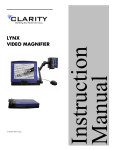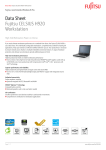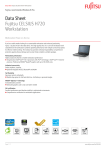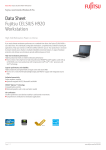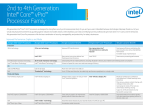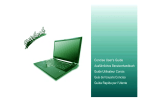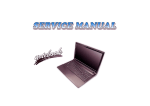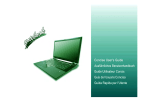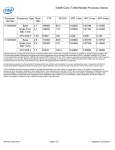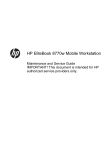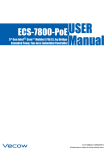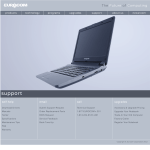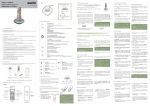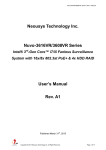Download External Locator - Bottom View
Transcript
Preface Instructions for Care and Operation The notebook computer is quite rugged, but it can be damaged. To prevent this, follow these suggestions: 1. Don’t drop it, or expose it to shock. If the computer falls, the case and the components could be damaged. Do not expose the computer to any shock or vibration. 2. Do not place anything heavy on the computer. Keep it dry, and don’t overheat it. Keep the computer and power supply away from any kind of heating element. This is an electrical appliance. If water or any other liquid gets into it, the computer could be badly damaged. Do not leave it in a place where foreign matter or moisture may affect the system. Don’t use or store the computer in a humid environment. Do not place the computer on any surface which will block the vents. Preface Do not expose it to excessive heat or direct sunlight. 3. Do not place it on an unstable surface. Follow the proper working procedures for the computer. Shut the computer down properly and don’t forget to save your work. Remember to periodically save your data as data may be lost if the battery is depleted. Do not turn off the power until you properly shut down all programs. Do not turn off any peripheral devices when the computer is on. Do not disassemble the computer by yourself. Perform routine maintenance on your computer. V Preface 4. 5. Avoid interference. Keep the computer away from high capacity transformers, electric motors, and other strong magnetic fields. These can hinder proper performance and damage your data. Take care when using peripheral devices. Use only approved brands of peripherals. Preface Power Safety Warning Before you undertake any upgrade procedures, make sure that you have turned off the power, and disconnected all peripherals and cables (including telephone lines and power cord). You must also remove your battery in order to prevent accidentally turning the machine on. Before removing the battery disconnect the AC/DC adapter from the computer. VI Unplug the power cord before attaching peripheral devices. Power Safety The computer has specific power requirements: • • • • • • Only use a power adapter approved for use with this computer. Your AC adapter may be designed for international travel but it still requires a steady, uninterrupted power supply. If you are unsure of your local power specifications, consult your service representative or local power company. The power adapter may have either a 2-prong or a 3-prong grounded plug. The third prong is an important safety feature; do not defeat its purpose. If you do not have access to a compatible outlet, have a qualified electrician install one. When you want to unplug the power cord, be sure to disconnect it by the plug head, not by its wire. Make sure the socket and any extension cord(s) you use can support the total current load of all the connected devices. Before cleaning the computer, make sure it is disconnected from any external power supplies. Do not plug in the power cord if you are wet. Do not use the power cord if it is broken. Do not place heavy objects on the power cord. Preface Battery Precautions • Only use batteries designed for this computer. The wrong battery type may explode, leak or damage the computer. • Do not continue to use a battery that has been dropped, or that appears damaged (e.g. bent or twisted) in any way. Even if the computer continues to work with a damaged battery in place, it may cause circuit damage, which may possibly result in fire. • Recharge the batteries using the notebook’s system. Incorrect recharging may make the battery explode. • Do not try to repair a battery pack. Refer any battery pack repair or replacement to your service representative or qualified service personnel. • Keep children away from, and promptly dispose of a damaged battery. Always dispose of batteries carefully. Batteries may explode or leak if exposed to fire, or improperly handled or discarded. • Keep the battery away from metal appliances. • Affix tape to the battery contacts before disposing of the battery. • Do not touch the battery contacts with your hands or metal objects. Battery Guidelines Preface The following can also apply to any backup batteries you may have. • If you do not use the battery for an extended period, then remove the battery from the computer for storage. • Before removing the battery for storage charge it to 60% - 70%. • Check stored batteries at least every 3 months and charge them to 60% - 70%. Battery Disposal The product that you have purchased contains a rechargeable battery. The battery is recyclable. At the end of its useful life, under various state and local laws, it may be illegal to dispose of this battery into the municipal waste stream. Check with your local solid waste officials for details in your area for recycling options or proper disposal. Caution Danger of explosion if battery is incorrectly replaced. Replace only with the same or equivalent type recommended by the manufacturer. Discard used battery according to the manufacturer’s instructions. Battery Level Click the battery icon in the taskbar to see the current battery level and charge status. A battery that drops below a level of 10% will not allow the computer to boot up. Make sure that any battery that drops below 10% is recharged within one week. VII Preface Related Documents You may also need to consult the following manual for additional information: User’s Manual on CD This describes the notebook PC’s features and the procedures for operating the computer and its ROM-based setup program. It also describes the installation and operation of the utility programs provided with the notebook PC. System Startup Preface 1. Remove all packing materials, and place the computer on a stable surface. 2. Insert the battery and make sure it is locked in position. 3. Securely attach any peripherals you want to use with the notebook (e.g. keyboard and mouse) to their ports. 4. Attach the AC/DC adapter to the DC-In jack at the rear of the computer, then plug the AC power cord into an outlet, and connect the AC power cord to the AC/DC adapter. 5. Use one hand to raise the lid/LCD to a comfortable viewing angle (it is preferable not to exceed 135 degrees); use the other hand to support the base of the computer (Note: Never lift the computer by the lid/LCD). 6. Raise the lid/LCD to a comfortable viewing angle, and press the power button. VIII 135° Figure 1 Computer with AC/DC Adapter Plugged-In / Opening the Lid/LCD Introduction System Specifications Processor Options Security Keyboard Intel® Core™ i7 Processor i7-3940XM (3.00GHz), i7-3920XM (2.90GHz) 8MB L3 Cache, 22nm, DDR3-1600MHz, TDP 55W Security (Kensington® Type) Lock Slot BIOS Password Illuminated Full-Size “WinKey” Keyboard (with W/A/S/D Gaming Keys and Numeric keypad) Fingerprint Reader Module TPM 1.2 Pointing Device Video Adapter 1.Introduction i7-3840QM (2.80GHz), i7-3820QM (2.70GHz) 8MB L3 Cache, 22nm, DDR3-1600MHz, TDP 45W i7-3740QM (2.70GHz), i7-3720QM (2.60GHz), i73610QM (2.30GHz) 6MB L3 Cache, 22nm, DDR3-1600MHz, TDP 45W LCD P370EM: 17.3" (43.94cm) FHD LCD P370EM3: 17.3" (43.94cm) FHD (1920 * 1080), 120Hz Support 3D solution with NV 3D VISION Kit (Shutter Glasses Only) Built-in 3D IR Emitter Memory Four 204 Pin SO-DIMM Sockets Supporting DDR3 1333/1600MHz Memory Memory Expandable up to 32GB Core Logic Intel® HM77 Chipset BIOS AMI BIOS (48Mb SPI Flash-ROM) 1 - 2 System Specifications P370EM: AMD Radeon™ HD 7970M PCIe Video Card 2GB GDDR5 Video RAM on board Microsoft DirectX® 11 (2nd Generation) Compatible Supports AMD CrossFireX Technology nVIDIA® GeForce GTX 670M PCIe Video Card 1.5GB GDDR5 Video RAM on board Microsoft DirectX® 11 Compatible Supports nVIDIA® SLI Technology nVIDIA® GeForce GTX 670MX PCIe Video Card 3GB GDDR5 Video RAM on board Microsoft DirectX® 11 Compatible Supports nVIDIA® SLI Technology nVIDIA® GeForce GTX 680M PCIe Video Card 4GB GDDR5 Video RAM on board Microsoft DirectX® 11 Compatible Supports nVIDIA® SLI Technology nVIDIA® Quadro K5000M PCIe Video Card 4GB GDDR5 Video RAM on board Microsoft DirectX® 11 Compatible OpenGL 4.1 Compatible P370EM3: nVIDIA® GeForce GTX 680M PCIe Video Card 4GB GDDR5 Video RAM on board Microsoft DirectX® 11 Compatible Supports nVIDIA® SLI Technology Built-in ClickPad (with Multi Gesture Functionality) Audio High Definition Audio Compliant Interface S/PDIF Digital Output Two Speakers One Sub Woofer Built-In Microphone Sound Blaster® X-Fi™ MB2 Interface Four USB 3.0 Ports (Including one AC/DC Powered USB port) One USB 2.0 Port One eSATA Port (USB 2.0 Port Combined) One HDMI-Out Port One DisPlayPort (Version is Video Controller Dependent) One S/PDIF Out Jack One Headphone/Speaker-Out Jack One Microphone-In Jack One Line-In Jack One RJ-45 LAN Jack One DC-In Jack Note: External 7.1CH Audio Output Supported by Headphone, Microphone, Line-In and S/PDIF Out Jacks Introduction Storage Environmental Spec Up to Two (Factory Option) Changeable 2.5" (6cm) 9.5mm (h) SATA (Serial) Hard Disk Drives/Solid State Drives (SSD) supporting RAID level 0/1/ Recovery Temperature (Factory Option) One mSATA Solid State Drive (SSD) (Factory Option) One 12.7mm(h) Optical Device Type Drive (Super Multi Drive/Blu-Ray Combo Drive/Blu-Ray Writer Drive) Mini-Card Slots Slot 1 for WLAN Module or Combo WLAN and Bluetooth Module Slot 2 for mSATA SSD Embedded Multi-In-1 Push-Push Card Reader MMC (MultiMedia Card) / RS MMC SD (Secure Digital) / Mini SD / SDHC/ SDXC MS (Memory Stick) / MS Pro / MS Duo Operating: 20% - 80% Non-Operating: 10% - 90% Power Removable 8-cell Smart Lithium-Ion Battery Pack, 89.21WH Full Range AC/DC Adapter AC Input: 100 - 240V, 50 - 60Hz DC Output: 19.5V, 16.9A (330W) 1.Introduction Card Reader Operating: 5°C - 35°C Non-Operating: -20°C - 60°C Relative Humidity Dimensions & Weight 419mm (w) * 293mm (d) * 39.3 - 49.7mm (h) Around 3.9kg with 1 Video Card, Battery and ODD Communication Built-In Giga Base-TX Ethernet LAN (Factory Option) 2.0M FHD PC Camera Module (Factory Option) Bluetooth 2.1 + EDR Module WLAN/ Bluetooth Half Mini-Card Modules: (Factory Option) Intel® Centrino® Ultimate-N 6300 Wireless LAN (802.11a/g/n) (Factory Option) Intel® Centrino® Advanced-N 6235 Wireless LAN (802.11a/g/n) + Bluetooth 4.0 (Factory Option) Intel® Centrino® Wireless-N 2230 Wireless LAN (802.11b/g/n) + Bluetooth 4.0 (Factory Option) Wireless LAN (802.11b/g/n) + Bluetooth 4.0 System Specifications 1 - 3 Introduction Figure 1 External Locator - Top View with LCD Panel Open Top View 1.Introduction 1. 2. 3. 4. 5. 6. 7. 8. 9. Built-In PC Camera PC Camera LED Built-In Microphone LCD Speakers LED Status Indicators Power Button Keyboard ClickPad and Buttons 10. Fingerprint Reader Module 2 1 3 4 5 6 5 7 8 10 9 1 - 4 External Locator - Top View with LCD Panel Open Introduction External Locator - Front & Right side Views Figure 2 Front Views 1. LED Power Indicators 1 1 2 3 4 5 5 1. Optical Device Drive Bay 2. Emergency Eject Hole 3. Combined eSATA/ USB 2.0 Port 4. Powered USB 3.0 Port 5. 2 * USB 3.0 Ports External Locator - Front & Right side Views 1 - 5 1.Introduction Figure 3 Right Side Views Introduction External Locator - Left Side & Rear View Figure 4 Left Side View 1. Security Lock Slot 2. RJ-45 LAN Jack 3. Multi-In-1 Card Reader 4. Line-In Jack 5. S/PDIF-Out Jack 6. Microphone-In Jack 7. Headphone-Out Jack 3 1 1.Introduction 2 4 5 6 7 Figure 5 Rear View 1. 2. 3. 4. 5. Fan Outlet/Intake HDMI-Out Port Display Port DC-In Jack 1 * USB 3.0 Port 1 1 - 6 External Locator - Left Side & Rear View 2 3 4 5 1 Introduction External Locator - Bottom View Figure 6 Bottom View 1. Fan Outlet/Intake 2. Component Bay Cover 3. Sub Woofer 4. Battery 5. HDD Bay 1 1 1 1 1.Introduction 2 3 1 4 5 Overheating To prevent your computer from overheating make sure nothing blocks the vent/fan intakes while the computer is in use. External Locator - Bottom View 1 - 7 Disassembly NOTE: All disassembly procedures assume that the system is turned OFF, and disconnected from any power supply (the battery is removed too). Maintenance Tools The following tools are recommended when working on the notebook PC: 2.Disassembly • • • • • • M3 Philips-head screwdriver M2.5 Philips-head screwdriver (magnetized) M2 Philips-head screwdriver Small flat-head screwdriver Pair of needle-nose pliers Anti-static wrist-strap Connections Connections within the computer are one of four types: 2 - 2 Overview Locking collar sockets for ribbon connectors To release these connectors, use a small flat-head screwdriver to gently pry the locking collar away from its base. When replacing the connection, make sure the connector is oriented in the same way. The pin1 side is usually not indicated. Pressure sockets for multi-wire connectors To release this connector type, grasp it at its head and gently rock it from side to side as you pull it out. Do not pull on the wires themselves. When replacing the connection, do not try to force it. The socket only fits one way. Pressure sockets for ribbon connectors To release these connectors, use a small pair of needle-nose pliers to gently lift the connector away from its socket. When replacing the connection, make sure the connector is oriented in the same way. The pin1 side is usually not indicated. Board-to-board or multi-pin sockets To separate the boards, gently rock them from side to side as you pull them apart. If the connection is very tight, use a small flat-head screwdriver - use just enough force to start. Disassembly Maintenance Precautions The following precautions are a reminder. To avoid personal injury or damage to the computer while performing a removal and/or replacement job, take the following precautions: Power Safety Warning Before you undertake any upgrade procedures, make sure that you have turned off the power, and disconnected all peripherals and cables (including telephone lines). It is advisable to also remove your battery in order to prevent accidentally turning the machine on. Cleaning Do not apply cleaner directly to the computer, use a soft clean cloth. Do not use volatile (petroleum distillates) or abrasive cleaners on any part of the computer. Overview 2 - 3 2.Disassembly 1. Don't drop it. Perform your repairs and/or upgrades on a stable surface. If the computer falls, the case and other components could be damaged. 2. Don't overheat it. Note the proximity of any heating elements. Keep the computer out of direct sunlight. 3. Avoid interference. Note the proximity of any high capacity transformers, electric motors, and other strong magnetic fields. These can hinder proper performance and damage components and/or data. You should also monitor the position of magnetized tools (i.e. screwdrivers). 4. Keep it dry. This is an electrical appliance. If water or any other liquid gets into it, the computer could be badly damaged. 5. Be careful with power. Avoid accidental shocks, discharges or explosions. •Before removing or servicing any part from the computer, turn the computer off and detach any power supplies. •When you want to unplug the power cord or any cable/wire, be sure to disconnect it by the plug head. Do not pull on the wire. 6. Peripherals – Turn off and detach any peripherals. 7. Beware of static discharge. ICs, such as the CPU and main support chips, are vulnerable to static electricity. Before handling any part in the computer, discharge any static electricity inside the computer. When handling a printed circuit board, do not use gloves or other materials which allow static electricity buildup. We suggest that you use an anti-static wrist strap instead. 8. Beware of corrosion. As you perform your job, avoid touching any connector leads. Even the cleanest hands produce oils which can attract corrosive elements. 9. Keep your work environment clean. Tobacco smoke, dust or other air-born particulate matter is often attracted to charged surfaces, reducing performance. 10. Keep track of the components. When removing or replacing any part, be careful not to leave small parts, such as screws, loose inside the computer. Disassembly Removing the Battery Figure 1 If you are confident in undertaking upgrade procedures yourself, for safety reasons it is best to remove the battery. a. Slide the latch and 1. Turn the computer off, remove the AC/DC adapter and turn it over. 2. Slide the latch 1 - 2 in the direction of the arrow and carefully pull the battery 3 up. 3. Lift the battery 3 up (Figure b) and out of the battery bay. a. Battery Removal hold it in place. b. Pull the battery up. c. Lift the battery out of the bay as indicated. c. 2.Disassembly 1 2 3 b. 3 3. Battery • Removing the Battery 2 - 5 Disassembly Figure 2 Optical Device Removal a. Remove the screw. b. Push the optical device out of the computer. Removing the Optical (CD/DVD) Device 1. Turn off the computer, and turn it over and remove the battery (page 2 - 5). 2. Remove the screw at point 1 , and use a screwdriver to carefully push out the optical device at point 2 . 3. Push the optical device drive 3 out of the bay and reverse the process to install the new device. . b. a. 2.Disassembly 2 1 3 Blu-Ray Device Bezel Removal 3. Optical Device • 1 Screw 2 - 6 Removing the Optical (CD/DVD) Device Note that some Blu-Ray modules (e.g. Pioneer) have a small piece of mylar inserted in the left side (as viewed front on) of the bezel cover; in order to prevent the bezel cover of the module from being removed accidentally. If you need to replace the bezel cover, you will need to use a screwdriver to ease out and remove the mylar before attempting to remove the bezel cover. You will need to re-insert the mylar when replacing the bezel cover. Disassembly Removing the Hard Disk Drive Figure 3 The hard disk drive is mounted in a removable case and can be taken out to accommodate other 2.5" SATA hard disk drives with a height of 9.5mm (h). Follow your operating system’s installation instructions, and install all necessary drivers and utilities (as outlined in Chapter 4 of the User’s Manual) when setting up a new hard disk. a. Remove the screw. b. Slide the cover in the direction of the arrow. c. Remove the bay cover. Hard Disk Upgrade Process 1. 2. 3. 4. HDD Assembly Removal Turn off the computer, and turn it over and remove the battery (page 2 - 5). Locate the Hard disk bay cover and remove the screw 1 . Slide the bay cover 3 in the direction of the arrow 2 . Carefully lift the bay cover 3 off the computer (Figure 3c). 2.Disassembly c. a. 1 3 b. 3. Hard disk Cover Bay 2 • 1 Screw Removing the Hard Disk Drive 2 - 7 Disassembly Figure 4 HDD Assembly Removal (cont’d.) d. Remove the screws. e. Slide the HDD in the direction of the arrow. f. Lift the hard disk assembly out off the computer. g. Remove the screws and mylar from HDD. 5. 6. 7. 8. 9. Remove screws 4 - 5 . Grip the tab and slide the hard disk assembly in the direction of the arrow 6 (Figure 4e). Carefully lift the hard disk assembly 7 out of the computer (Figure 4f). Remove screws 8 - 11 and hard disk mylar 12 from the hard disk(s) 13 (Figure 4g). Reverse the process to install a new hard disk (do not forget to replace all the screws and cover). d. g. f. 4 9 10 8 2.Disassembly 11 12 5 7 e. 6 7 Hard Disk Assembly 12. Hard Disk Mylar 13. Hard Disk • 6 Screws 2 - 8 Removing the Hard Disk Drive 13 Disassembly Removing the Hard Disk(s) in the Secondary HDD Bay 1. 2. 3. 4. 5. 6. Turn off the computer, and turn it over and remove the battery. The secondary hard disk bay is located under the first hard disk. Grip the tab and slide the hard disk assembly in the direction of the arrow 1 (Figure 5a). Lift the hard disk assembly 2 out of the compartment (Figure 5b). Remove the screws 3 - 6 to release the hard disk 8 from the case 7 (Figure 5c). Reverse the process to install any new hard disk(s). 3 c. a. 4 6 Figure 5 Secondary HDD Assembly Removal 7 1 5 8 b. 2. Hard Disk Assembly 7. Hard Disk Case 8. Hard Disks 2 • 4 Screws 2 Removing the Hard Disk Drive 2 - 9 2.Disassembly a. Slide the secondary hard disk assembly in the direction of the arrow. b. Lift the secondary hard disk assembly out off the computer. c. Remove the screws to release the hard disk from the case. Disassembly Figure 6 2.Disassembly Keyboard Removal a. Unsnap the LED cover at point 2 using non-metallic instrument. b. Lift the LED cover module and remove the screws from the keyboard. c. Disconnect the cables from the locking collar. d. Remove the keyboard. Removing the Keyboard 1. Turn off the computer, and turn it over and remove the battery (page 2 - 5). 2. Turn the computer over, open the Lid/LCD, and carefully unsnap up the center cover module 1 from point 2 (between F11 & F12) using non-metallic instrument. 3. Lift up the center cover module 1 off the computer. 4. Remove screws 3 - 7 from the keyboard. 5. Carefully lift the keyboard 8 up, being careful not to bend the keyboard ribbon cable. 6. Disconnect the keyboard ribbon cable 9 from the locking collar socket 10 , and the keyboard LED cable 11 from its locking collar socket 12 . 7. Remove the keyboard 8 . 8. Reverse the process to replace the keyboard (make sure to reconnect the keyboard cable). c. a. 1 8 2 9 11 10 12 b. 3 4 5 6 7 Re-Inserting the Keyboard 1. Center Cover Module 8. Keyboard • 5 Screws 2 - 10 Removing the Keyboard 1 When re-inserting the keyboard firstly align the keyboard tabs at the bottom of the keyboard with the slots in the case. Disassembly Removing the System Memory (RAM) The computer has three memory sockets for 204 pin Small Outline Dual In-line Memory Modules (SO-DIMM) DDR III (DDR3) supporting 1333/1600 MHz. The main memory can be expanded up to 16GB. The total memory size is automatically detected by the POST routine once you turn on your computer. Primary System Memory Upgrade Process 1. Turn off the computer, and turn it over to remove the battery (page 2 - 5). 2. Remove screws 1 - 4 and component bay cover 5 . 3. The RAM module will be visible at point 6 on the mainboard (Figure 7b). a. 2 4 3 a. Remove screws and component bay cover. b. Locate the module. 5 Contact Warning Be careful not to touch the metal pins on the module’s connecting edge. Even the cleanest hands have oils which can attract particles, and degrade the module’s performance. b. 6 5. Component Bay Cover • 4 Screws Removing the System Memory (RAM) 2 - 11 2.Disassembly 1 Figure 7 RAM-1 Module Removal Disassembly Figure 8 RAM-1 Module Removal (cont’d.) c. Gently pull the release latch in the direction indicated. d. Remove the module. 4. Gently pull the two release latches 7 & 8 on the sides of the memory socket in the direction indicated by the arrows (Figure 8c). 5. The RAM module 9 will pop-up, and you can then remove it. 6. Pull the latches to release the second module if necessary c. d. 9 2.Disassembly 7 8 7. Insert a new module holding it at about a 30° angle and fit the connectors firmly into the memory slot. 8. The module’s pin alignment will allow it to only fit one way. Make sure the module is seated as far into the socket as it will go. DO NOT FORCE the module; it should fit without much pressure. 9. Press the module in and down towards the mainboard until the slot levers click into place to secure the module. 10. Replace the component bay cover and screws. 11. Restart the computer to allow the BIOS to register the new memory configuration as it starts up. 9. RAM Module 2 - 12 Removing the System Memory (RAM) Disassembly Secondary System Memory Upgrade Process Figure 9 1. Turn off the computer, and turn it over to remove the battery (page 2 - 5), and keyboard (page 2 - 10). 2. The RAM module will be visible at point 1 on the mainboard (Figure 9a). a. c. 1 RAM-2 Module Removal a. Locate the module. b. Gently pull the release latch in the direction indicated. c. Remove the module. 4 2 2 3 Contact Warning Be careful not to touch the metal pins on the module’s connecting edge. Even the cleanest hands have oils which can attract particles, and degrade the module’s performance. 3 3. Gently pull the two release latches 2 & 3 on the sides of the memory socket in the direction indicated by the arrows (Figure 8c). 4. The RAM module 4 will pop-up, and you can then remove it. 5. Pull the latches to release the second module if necessary 6. Insert a new module holding it at about a 30° angle and fit the connectors firmly into the memory slot. 7. The module’s pin alignment will allow it to only fit one way. Make sure the module is seated as far into the socket as it will go. DO NOT FORCE the module; it should fit without much pressure. 8. Press the module in and down towards the mainboard until the slot levers click into place to secure the module. 9. Replace the screws and keyboard. 10. Restart the computer to allow the BIOS to register the new memory configuration as it starts up. 4. RAM Module Removing the System Memory (RAM) 2 - 13 2.Disassembly b. Disassembly Removing the Wireless LAN Module Figure 21 1. Turn off the computer, and turn it over, remove the battery (page 2 - 5), keyboard and keyboard shielding plate (page 2 - 10). 2. The Wireless LAN Module will be visible at point 1 . 3. Remove the screw 2 and carefully disconnect cables 3 - 4 . 4. The Wireless LAN Module 5 (Figure c) will pop-up, and you can remove it. a. c. Wireless LAN Module Removal a. Locate the WLAN module. b. Remove the screw and disconnect the cables. c. Remove the WLAN module. 1 Note: Make sure you reconnect the antenna cables. b. 2 3 4 5 5. Wireless LAN Module • 1 Screw Removing the Wireless LAN Module 2 - 25 2.Disassembly 5























